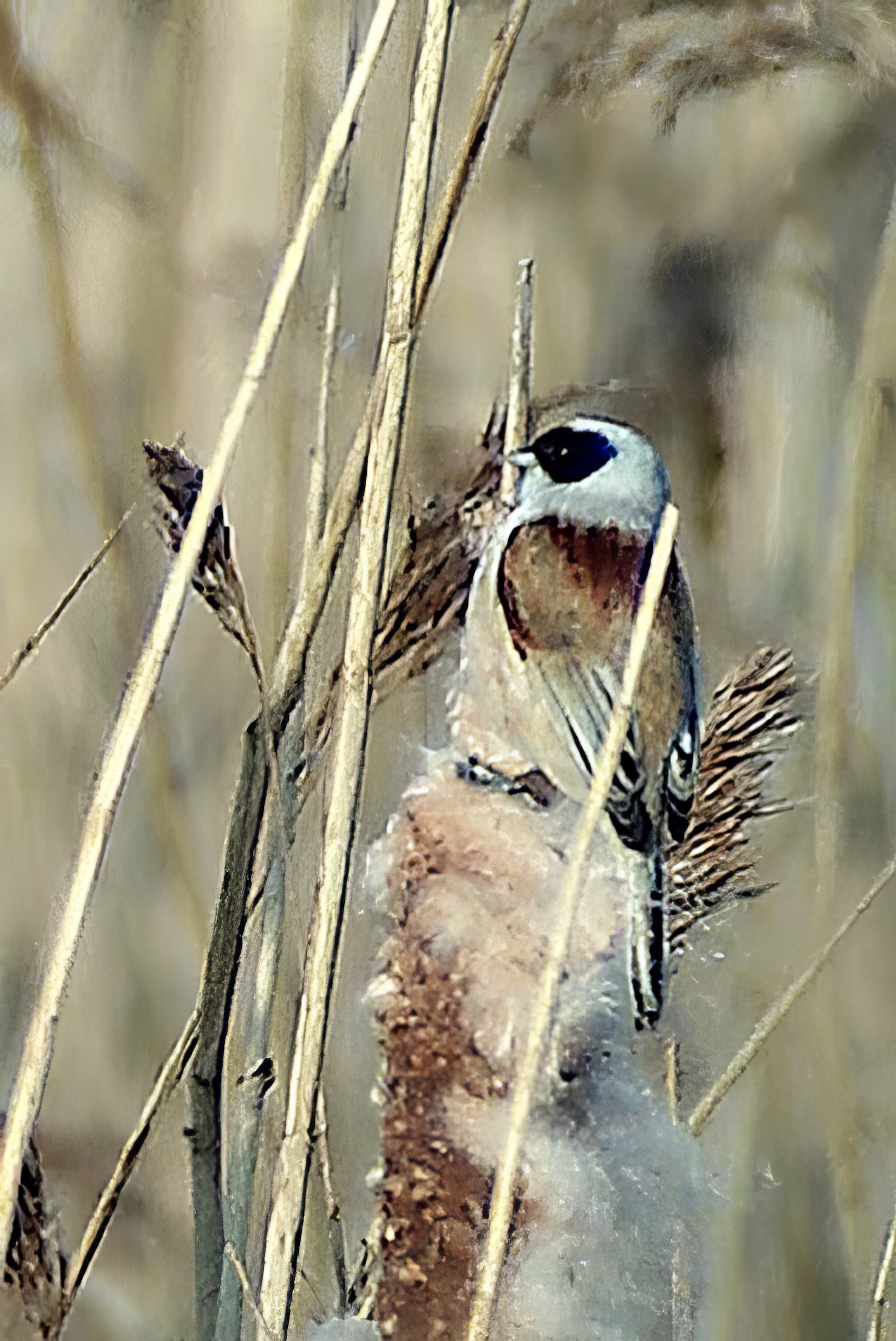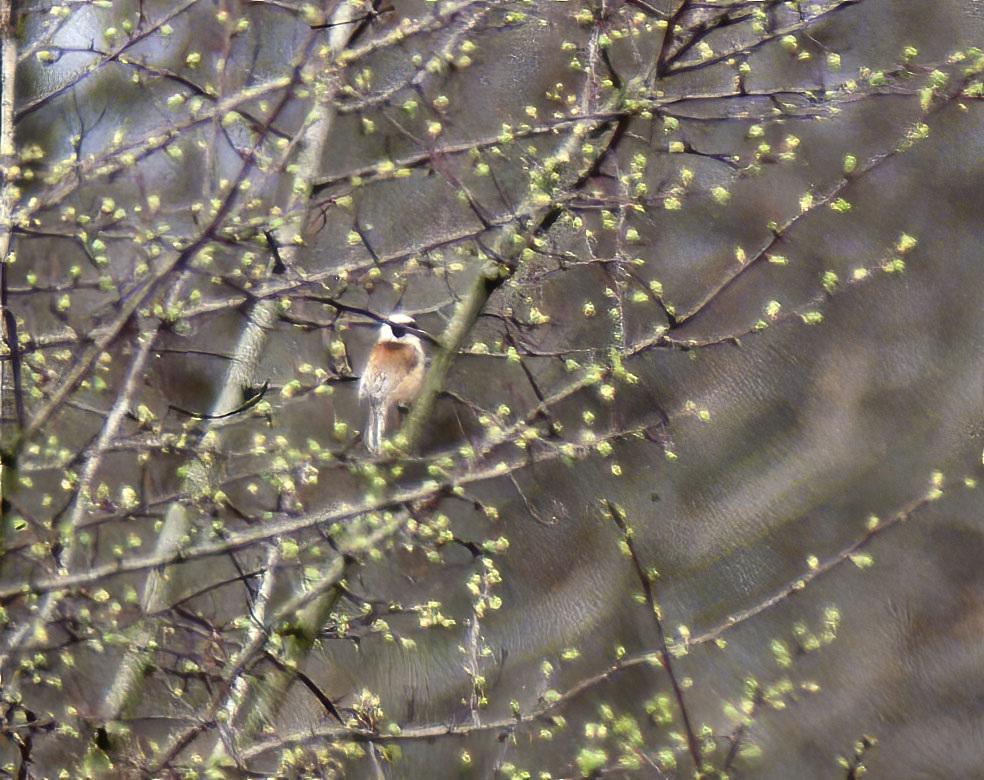Penduline Tit Remiz pendulinus
Vagrant. Southern and Eastern Europe


An adult male was found in the late afternoon of October 14th, 1991 in the reed bed at Wolla Bank Pit; it was seen only briefly and was presumed to have gone to roost. The next day other observers visited the same site to search for the male and to their surprise saw both this and a female. They were observed there for only 35 minutes and once flew up very high before dropping back into the reed bed but flew off shortly afterwards. These were the first records for the county. The second record involved a brief visit of a male at Shoveler's Pool, Gibraltar Point in April 1994. The third, which was also the second for Gibraltar Point NNR, was again seen only briefly (but excellently photographed) in June 2000. The final record involved yet another male less than a year later, this time at Barton Pits in April 2001. There have been none since despite regular occurrences elsewhere in Britain with about 10 records per year up to 2014, which was the last year it was considered by BBRC.
From the 1970s the species has expanded across central Europe and birds ringed in France (2), Sweden (1) and The Netherlands (1) have been found in Britain. A male was seen at a nest in Kent in April-May 1990 and another adult with a brood patch was trapped in northern England in a reed bed in July 1992, but there has been no other evidence of breeding thereafter and they have not featured in the RBBP reports up to 2018.
| Site | First date | Last date | Count | Notes |
| Wolla Bank Pits, Chapel St. Leonard's | 14/10/1991 | - | 1 | Adult male. |
| Wolla Bank Pits, Chapel St. Leonard's | 15/10/1991 | - | 2 | Same adult male + female. |
| Gibraltar Point NNR | 27/10/1994 | - | 1 | Adult male. |
| Gibraltar Point NNR | 13/06/2000 | - | 1 | Adult male. |
| Water's Edge CP, Barton upon Humber | 10/04/2001 | 11/04/2001 | 1 | Adult male. |
Finder's report: Penduline Tits, new to Lincolnshire, October 14th, 1991.
by K. Atkin and C. J. Jennings.
Note: this account appeared in the Lincolnshire BIrd Report for 1991. There were 10 records in 1991, bringing the total for Great Britain to 66; the first record for Great Britain was in 1966. It ceased to be considered by BBRC in 2015. RBBP report that a male built a nest in Kent in 1990, one with brood a patch was trapped in Cleveland in 1992 and a male was in song in Kent in March-April 2010, but there has been no confirmation of breeding just yet.
Circumstances
In the late afternoon of October 14th, 1991, I visited Wolla Bank Pits after failing to locate a Pallas’s Warbler which had been seen nearby at Anderby Creek the previous day. As I watched some ducks fly off from the pit, I noticed out of the corner of my eye a small bird fly up from the reeds and drop back in again. Expecting to find possibly a Reed Bunting I tried to flush it and to my surprise a brightly coloured bird flew up and dropped back again. It the climbed to the top of a reed stem and looked at me when I could see it was a male Penduline Tit. It only stayed there briefly before flying about 15 metres across the pit and dropping out of sight in the reeds. It did not reappear, so I made a few notes but decided not to try and flush it again as it seemed as though it had gone to roost. In total it was only visible for about ten seconds.
Description
A small tit-like bird with a greyish-white head and neck and boldly contrasting sharply defined jet-black mask from the bill, where narrow, through and broadening behind the eye. The back and wing coverts were a bright chestnut brown, and the underparts were pale buffish-white. The wings and tail were very dark but boldly fringed white. The legs were dark, but bill colour not noticed.
E J Mackrill (EJM) phoned me the following morning to say he had seen two birds a male and probable female. Apparently, the birds were still irruptive as they had once flown up very high before dropping back in again. They could not be found again although I and others searched later that day and subsequently at other pits.
Keith Atkin.
October 15th, 1991
EJM and I met at Wolla Bank Pit at 07.00h on October 15th; we split up to search for the birds and R. K. Watson (RKW) arrived at 07.30h and joined the search. At 08:00hrs a movement in the reeds caught my eye and a male Penduline Tit came into view after a few seconds of quiet pishing from me. After about 10 or more seconds of looking at the bird (and my pulse had settled down) I looked around for my companions. RKW was about 50m distant, and I waved to him to indicate the bird’s presence. At this time the bird flew off accompanied by another I had not previously seen and went back into the reeds about 30m distant. I whistled quite loudly and EJM appeared quite close to the birds and obtained good views. When RKW and myself joined him the birds had gone into the reeds and disappeared. The birds were then relocated in the original spot and EJM and I observed them from 5m. At 08:35 the birds flew off and although they appeared to come down in the opposite side of the reserve, they were not seen again thereafter.
Description
Male: crown and nape grey; bill black and conical. Black mask from over bill to rear of eye and ear coverts. Mantle, scapulars, and coverts chestnut. Flight feathers and tail all black with narrow white edges. Chin and throat white merging into buff underparts darker at breast sides.Female: As male but with narrower mask and duller brown mantle.
C. J. Jennings
(Account as per new Birds of Lincolnshire (2021), included October 2022)

